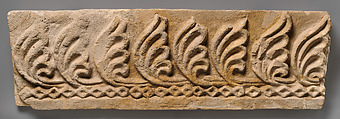Wall decoration with vegetal and geometric design
Not on view
Stucco reliefs were commonly used to decorate the iwans and reception halls of elite Sasanian houses. Many examples were found in excavated houses in the Ctesiphon area including this fragment from Ma’aridh VI consisting of a design of half palmettes above a row of lozenges. The use of molds to make stuccos allowed for the creation of large scale repetitive patterns such as floral and vegetal motifs
The city of Ctesiphon was located on the east bank of the Tigris River, 20 miles (32 km) south of modern Baghdad in Iraq. It flourished for more than 800 years as the capital of the Parthians and the Sasanians, the last two dynasties to rule the ancient Near East before the Islamic conquest in the seventh century. Systematic excavations in the Ctesiphon area were undertaken by an expedition in 1928–29 sponsored by the German Oriental Society (Deutsche Orient-Gesellschaft). The Metropolitan Museum of Art and the Staatliche Museen, Berlin, undertook a joint expedition for one season in 1931–32. Several excavations were conducted, including at the main palace (Taq-i Kisra), in a small fortified area south of the palace at Tell Dheheb, at multiple houses at the mounds of Ma’aridh, and at additional houses at a small mound called Umm ez-Za’tir.
Over the course of the excavations in the Ctesiphon area, six houses from a series of small mounds called el Ma’aridh were excavated. The house at Ma’aridh VI was only partially excavated and a plan of the building was not made. The stucco fragments from the house, however, suggest that the cruciform niches in the reception area were richly decorated.
Due to rights restrictions, this image cannot be enlarged, viewed at full screen, or downloaded.

